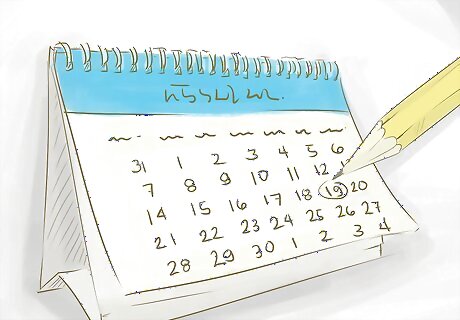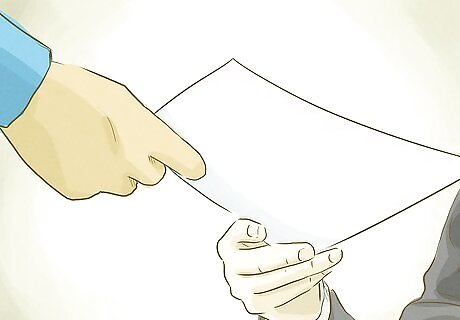
views
X
Trustworthy Source
National Paralegal College Law Shelf
Online education resource from the National Paralegal College
Go to source
Once you are served with these documents – typically by a sheriff's deputy who shows up at your house and delivers them – you must provide a written response within a certain period of time. If this response is not filed with the court by the deadline on the summons, the person who sued you could win their case by default.[2]
X
Trustworthy Source
Civil Law Help Center
Nonprofit law firm dedicated to civil legal services to all people
Go to source
Preparing Your Answer

Read the complaint and summons. The complaint and summons provide information on who is suing you, why you are being sued, and how long you have to respond to the lawsuit. The complaint tells the judge what the dispute is about, and what the person suing you wants from you. The plaintiff, or person suing you, cannot proceed with his or her lawsuit until you have received a copy of the complaint and summons and have legal notice of it. The summons provides logistical details for you, including a statement of the fact that you have the right to respond to the complaint in writing within a certain amount of time. It will tell you how long you have to respond, and where you should take your written response.

Consider hiring an attorney. Legal expertise can be invaluable in defending against a lawsuit, particularly if you are being sued for a significant sum of money or if the person suing you has retained legal representation. An experienced attorney may be able to identify defenses available to you under the law of which you were not aware, or can assist with settling the case out of court, saving you a lot of time and money. Even if you believe you cannot afford an attorney, you may be able to find someone who is willing to provide a free consultation on your case and give you limited advice. You also may want to check with legal aid services or law school clinics in your area.

Determine your deadline to respond. The summons should include a date or time period by which you must respond. Typically, you have 20 days from the date you were served with the documents to respond to the lawsuit. However, this period may specify business days, or may be extended for certain court holidays. If you don't file a written response to the lawsuit, the judge will assume that you agree with everything the plaintiff stated in the complaint. The time limit may be different depending on the type of case filed. Make sure you read your summons carefully, as it will tell you how long you have to respond. If you've only received a summons, and have not received a complaint, you typically still need to file a notice of appearance along with a demand for a complaint. These forms will be available at the clerk's office of the court that issued the summons.

Research the law for the case. Once you've read the complaint and understand why you are being sued, the elements of the law can give you insights into the strengths and weaknesses of the case against you. The elements of the law dictate what the plaintiff must allege in the complaint to state a claim against you. If all of the elements of the claim aren't included in the complaint, you have an affirmative defense that the plaintiff has failed to state a claim. For example, if your neighbor is suing you for breach of contract, but his complaint does not allege that the two of you entered into a contractual agreement, you could state that he failed to state a claim. In addition to reading the specific law that provides the legal basis for the plaintiff's lawsuit, you also should review the procedural rules regarding the filing and service of a complaint. If the plaintiff didn't follow the correct legal procedure in serving you with a copy of the complaint, you have an affirmative defense that you were improperly served.

Decide whether the court has jurisdiction. To hear a case, the court must have jurisdiction over both the defendant and the subject matter of the claim. Each state organizes its court system somewhat differently. Typically, certain courts have limited jurisdiction over certain types of cases. There also will be a court with general jurisdiction over all civil claims. If you live in the state, or if the event that gave rise to the dispute happened in that state, that state's courts generally have jurisdiction over the subject matter of the claim. The court also must have the power to order you to do something, in the event the plaintiff wins the lawsuit. This is called personal jurisdiction. The court in the county where you live typically has personal jurisdiction. If you're being sued in your business capacity – for example, if you own a restaurant – any court in a county where you do business usually has personal jurisdiction. If the plaintiff has filed in the wrong court, you have an affirmative defense that the court does not have jurisdiction over your case. However, even if successful, courts typically will dismiss a lawsuit "without prejudice," meaning that the plaintiff is free to file the same lawsuit again in the correct court.

Find out the statute of limitations. The law provides deadlines after which a plaintiff cannot sue you. States have different time periods for filing different types of lawsuits, so if you happen to know the statute of limitations for one type of lawsuit, don't assume it will be the same for another. For example, California law gives plaintiffs only two years to file a personal injury claim, but four years to sue for breach of a written contract.

Evaluate whether you have any affirmative defenses or counterclaims. If you don't raise certain applicable affirmative defenses in your answer to the complaint, you may lose the right to raise them later. While the plaintiff has the burden of proof for the allegations listed in the complaint, you must prove the facts underlying any affirmative defenses and counterclaims. If you have a counterclaim that comes from the same incident or dispute that gave rise to the plaintiff's claim, you must include it in response to the plaintiff's claim – you cannot file a separate lawsuit. For example, if the plaintiff is suing you for damage to her car as a result of an accident, and you want to sue her for damage to your car, this would be a compulsory counterclaim since both cars were damaged in the same wreck. You only have one opportunity to raise certain defenses, such as lack of proper service. If these defenses aren't included in your answer, the court treats them as waived.

Consider filing a motion to dismiss. Some affirmative defenses are fatal to the plaintiff's lawsuit. If one of those defenses applies to the case, you can file a motion to dismiss instead of an answer. For example, if the plaintiff failed to file her lawsuit before the deadline required by the applicable statute of limitations, you could file a motion to dismiss because she no longer has the ability to sue you. Filing a motion to dismiss temporarily puts the time you have to file an answer on hold while the judge considers your motion. If the judge doesn't grant your motion, you have a brief period of time to file your answer – typically about 10 days. If you decide to file a motion to dismiss, you probably want to draft your answer anyway, so you have it ready to file in case the judge doesn't dismiss the plaintiff's lawsuit.
Writing Your Answer

Search for forms. Some courts have forms you can fill out to answer certain common types of complaints such as debt collector lawsuits. The caption of the complaint will tell you the name of the court where the plaintiff filed the lawsuit. Each court may have its own forms, or require different formats for answers and other documents filed. If you find a fill-in-the-blank form, make sure you either type your answers or print neatly so your answers are legible.

Create your caption. The caption is the heading found at the top of all documents filed in a case. Each court has a particular format for the caption, which includes the case number, parties to the case, and court where the case is filed. Typically you can copy the caption from the complaint you received. If the complaint doesn't have a file number, that means the plaintiff served you before filing the complaint with the court. If the complaint you received doesn't have a file number, you may not have to file your answer with the court yet, but you still must have it served on the plaintiff by the deadline listed on your summons. You must copy the information in the caption exactly as it is in the complaint, even if it is incorrect. For example, if your name is Jon Smithe, but the complaint caption lists your name as John Smith, you must type it as John Smith. You would then have an affirmative defense that the plaintiff sued the wrong person because your name wasn't spelled correctly.

Write your introduction. An answer typically starts with a single sentence that states who you are and what you are doing. If you were able to find a prepared form, it probably already has this sentence written, although it might have a blank for your name. If you're drafting your own answer from scratch, include a line such as "Defendant answers the complaint as follows." You can include your name, or the plaintiff's name, or even the name of the case if you want, but these details typically aren't legally required.

Respond to the allegations in the complaint. Any allegation not addressed specifically is considered to be admitted. Each allegation will be listed in the complaint in numbered paragraphs. You have three options for each allegation: you may admit, deny, or state that you lack sufficient knowledge to either admit or deny the statement. Keep in mind that denying something is not saying that it isn't true. If you deny a statement, that means you believe the plaintiff lacks sufficient evidence to prove legally that it is true. In contrast, when you admit something, that means the plaintiff doesn't have to prove it's true. Be careful with your admissions, and don't guess or assume that something is true just because it's included in the complaint. If you have questions or doubt the allegation, you probably should deny it. Only admit an allegation if you agree that every part of it is a true statement. State that you lack knowledge if you're confused by the allegation or don't understand what it means.

State your affirmative defenses or counterclaims. After you've responded to all allegations in the complaint, you should raise any affirmative defenses you have, or provide your own allegations if you also have a claim against the plaintiff. For example, if your state's law requires a plaintiff to file a personal injury lawsuit within one year of the injury, and you are being sued by someone who slipped and fell on your property three years ago, you could state the affirmative defense that the statute of limitations had run. If you include any counterclaims, you should follow the same basic format as the complaint, listing your allegations in numbered paragraphs.

Create your signature block. Include space for your signature, then type your name and address. You can include additional contact information such as your telephone number or email address if you like. The plaintiff and the court will use this information to contact you. If the complaint has been signed in front of a notary, it is called a "verified" complaint. Generally, you must respond to a verified complaint with a verified answer, which means you must sign your answer in the presence of a notary. However, if the complaint isn't verified, you typically don't have to provide a verified answer.
Filing Your Answer

Review local court procedures. Before you file your answer with the court, find out the local rules for responding to a complaint and serving the plaintiff with your answer. In some jurisdictions, there may be other documents you must file with your answer, such as an appearance or a civil court cover sheet. For example, if you're answering a debt collection lawsuit in Washington, you also must file a Declaration of Exempt Income and Assets, which is a sworn statement from you listing income or assets that creditors cannot take from you to satisfy delinquent debt, pursuant to the Fair Debt Collection Practices Act. Some jurisdictions such as New York County have electronic filing systems that are mandatory. This means that with limited exceptions, you cannot file your answer by taking the documents to the court house and handing them to the clerk. Before you prepare to file your answer, check the court's website or call the clerk's office to make sure you're using the correct procedures. Otherwise your answer may not be filed by the deadline and you risk having a default judgment entered against you.

Make copies of your answer. You will need at least two copies of your answer, one for your records and one for the person who sued you. You must file the originals. Make your copies after you've signed your documents, and take both the originals and the copies to the clerk's office. The clerk will stamp the originals as well as the copies, indicating the date they were filed.

Have the plaintiff served with your answer. The plaintiff must have legal notice of your response to the complaint. Typically you have the option of either having the plaintiff served by mailing a copy of your answer and any other documents using certified mail, or having a copy hand-delivered by a sheriff's deputy or private process serving company. Some courts require certain methods of service for certain types of cases. If a particular method is required, the clerk can let you know. This information also may be included on the certificate of service form. If you opt for hand delivery, you generally can't deliver your answer yourself. It must be done by someone over the age of 18 who is not a party to the case. If the plaintiff is represented by an attorney, you must deliver your answer to the attorney's office. The address will be listed on the complaint. However, if the plaintiff does not have an attorney you must deliver your answer directly to the plaintiff. When you serve the plaintiff, you must fill out a certificate of service to file with the court. This document tells the court when and how you served the plaintiff with your answer. If you haven't filed your original answer yet, you can attach the certificate of service to that document and file them all at once.

Take your answer to the clerk's office. You must file your answer with the clerk of the same court in which the plaintiff filed the lawsuit against you. If you've already served the plaintiff with a copy of your answer, you can attach your certificate of service to your answer when you file it with the clerk. If the summons and complaint that you received didn't have a case number, you can't file your answer yet. You will receive notice of the case number when the plaintiff files the complaint with the court. Until then, the court will have no record of the case. When you file your answer, you typically will have to pay a filing fee. The amount of the fee varies from court to court, but may be as much as $200 or $300. If you are unable to pay the filing fees, you can ask the clerk for a fee waiver application. On the application, you must disclose information about your income and assets. The court will review this information and determine if you are eligible to have the fees waived. If you're filing a motion to dismiss rather than an answer, the court clerk typically will give you a date that your motion is scheduled to be heard by the judge. Make sure you include this date on your certificate of service. If your answer included a counterclaim, the plaintiff will have a deadline to respond to your counterclaim, the same way you had a deadline to respond to the plaintiff's initial claim. This may be the same period of time that you had to respond, or it may be a shorter period. The court clerk will be able to tell you how long the plaintiff has to respond to your counterclaim.

Attempt to negotiate a settlement. In many situations, coming to a compromise and settling with the plaintiff will be less expensive and time-consuming than going to trial. Technically, you can negotiate a settlement with the plaintiff at any time. However, given that you only have a limited period of time to file an answer, your interests may be best served by filing your answer first and then contacting the plaintiff.

Consider mediation. A neutral, third-party mediator may be able to help you and the plaintiff resolve the dispute. For some types of claims, the court will require you to participate in mediation before a trial or other hearings can be scheduled. In this case, typically it is the plaintiff's responsibility to schedule the appointment with a mediator.



















Comments
0 comment